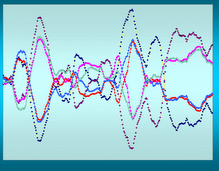I've done some thinking about this and a couple of studies and we will get to the math in a minute. The most exciting news is that Proshares seems to have worked out their problems with these two ETF's and they have established the mirror image that they are supposed to have.

Even the most casual observer will see that these two funds were skewed early in their history but now they are achieving that most wonderful moment of all - symmetry. Of course that's because of the averaging that we go through in Marlyn's Curve. We would expect to see symmetry if the funds were supposed to be symmetrical.
But are the results of each fund symmetrical as well? Over 178 days during which there were 102 days when you could have bought QLD or sold QID the average returns were 1.01248% (QLD) vs 1.01286% (QID). Which is not much variance on a share by share basis - but over thousands of shares and hundreds of transactions it could add up to a significant amount of money.
But sometimes percentages are not all they are cracked up to be. Sometimes you need to go into the numbers to get the real story. And that is what I did - Instead of looking at raw percentages I looked at the dollar rate of return for each transaction. And then I summed that value and took an average across all of the transactions. Needless to say on that basis QLD came out the best ($1.02 to .70) but ... and there's always a "but" ... I failed to normalize the prices one to another - in other words I needed to make them equivalent money-wise. Once I did that here is what I found.
In the first half of the 178 day period the return was $1.201 per basis for QID vs.
$1.125 per basis for QLD. Over the entire period the return per basis for QID was 1.078 vs. 1.026 for QLD.
On Friday for example had you shorted 1.95 shares for every one share you could have purchased of QLD you would have made $2.38 vs $2.14 per transactional basis. But (another "but") that's an awful lot of math for a simple stock transaction so lets look at it another way.
Had you just shorted 1000 shares of QID you would have made $1220 and had you bought a 1000 shares of QLD you would have made $2140. But you would have had to have put up over 90 thousand dollars in the QLD transaction and a minuscule percentage of that in the QID transaction.
So my thinking is this. On days when you can be pretty sure that the market is going up (and Friday would have been a good one) shorting the QID model seems to be the better idea if you can get the shares - and that might be the only difficulty with this whole idea.
Of course if you want a technical reason to buy or short either of the products you would put up a four-minute chart of either or both of them with an EMA 90 and wait for the cross.
Here is QID on Friday -

And here is QLD -

You can see how once the stocks crossed the EMA 90 the die was cast and it was an easy trade to make either way.



